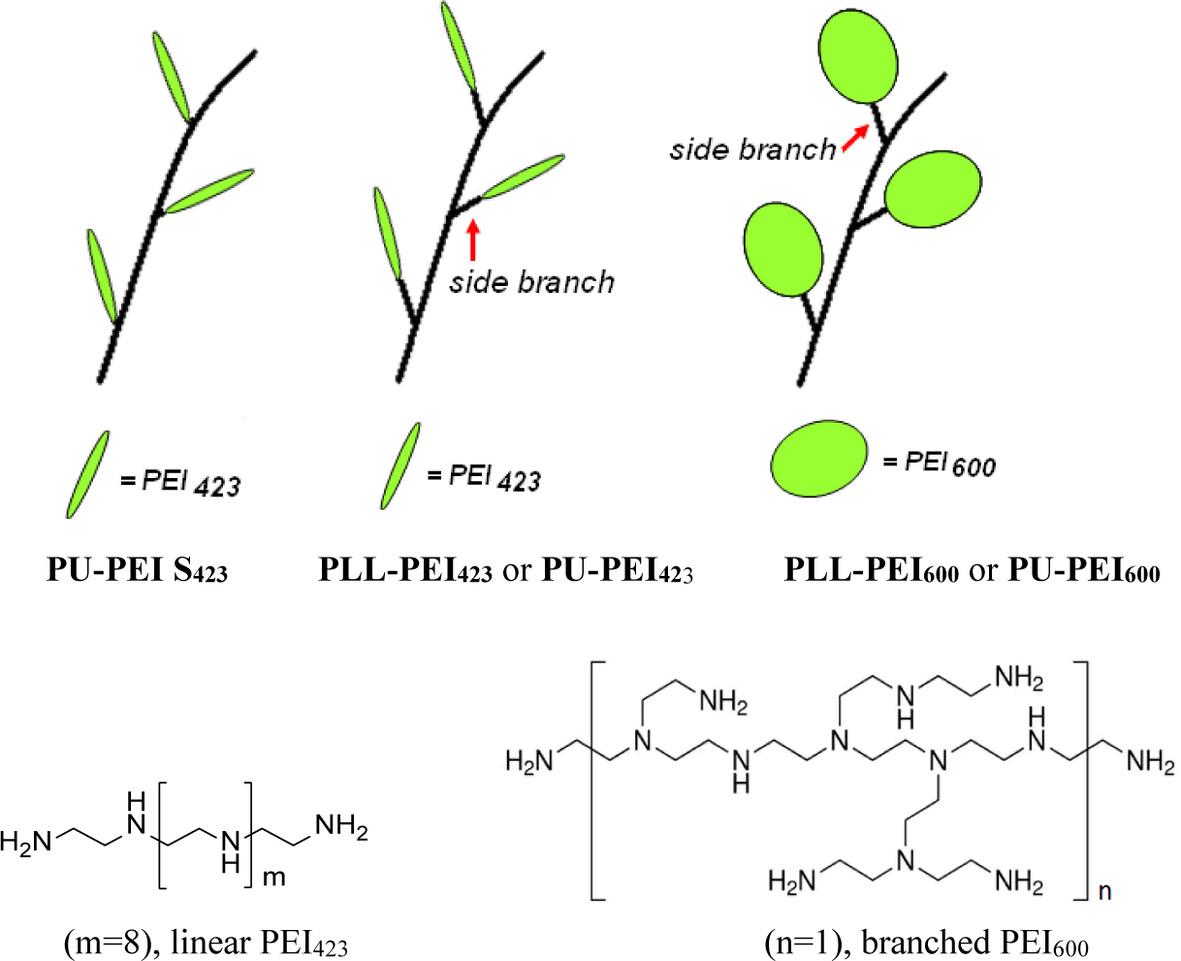求助PDF
{"title":"Synthesis and comparison of cationic polymers for structural effects of backbones and grafted side chains on their DNA transfection for efficient gene delivery","authors":"Ting-Yi Hou, Kuang-Hung Pan, Mei-Fen Shih, Jong-Yuh Cherng","doi":"10.1002/pi.6662","DOIUrl":null,"url":null,"abstract":"<p>Many cationic polymers with varied architectures either in backbones or in side chains have been used for gene delivery. However, these polymers yielding different DNA transfection efficiency cannot answer whether backbones or side chains have more influence on DNA delivery. In this research, polyurethanes (PUs) made from the reaction of <span>l</span>-lysine diisocyanate and 1,4-piperazinediethanol were synthesized. Together with poly(<span>l-</span>lysine) (PLL), these polymers were further modified to carry side chains by connecting to low-molecular-weight polyethylenimine (PEI) via imine linkages. The PEI was either linear (423 Da) or branched (600 Da) and grafted to the backbone representing two distinct shapes (i.e. a twig with needle-leaves or round-leaves). In addition, one PU derivative was synthesized to have shorter side chains (as PU-PEI S<sub>423</sub>) than PU-PEI<sub>423</sub> by aminolysis reaction. These synthesized polymers were compared for their transfection potential as gene vectors into cells. Electrophoretic mobility, dynamic light scattering and zeta potential analyses of polymer/DNA complexes confirmed that, after grafting of PEI (PEI<sub>423</sub> or PEI<sub>600</sub>), PLL-PEIs and PU-PEIs were able to self-assemble with plasmid DNA to form nano-scaled (<i>ca</i> 200 nm) and positively charged (<i>ca</i> +25 mV) complexes. These cationic polymers hardly showed any cytotoxicity on COS-7 cells. The outcome of fluorescence imaging and flow cytometry verified that the order of greater transfection efficiency is PLL-PEI<sub>600</sub> = PU-PEI<sub>600</sub> > PLL-PEI<sub>423</sub> = PU-PEI<sub>423</sub> > PEI<sub>25K</sub> (commercial standard) = PU-PEI S<sub>423</sub> >> PLL > PEI<sub>423</sub> = PEI<sub>600</sub> (starting materials). These results reveal that the polymers with longer side chains or higher charge density have positive influence on transfection efficiency. Nevertheless, different polymer backbones may reflect their biodegradability and cytotoxicity, but their effect on transfection efficiency is less significant. © 2024 Society of Chemical Industry.</p>","PeriodicalId":20404,"journal":{"name":"Polymer International","volume":"73 10","pages":"803-814"},"PeriodicalIF":3.6000,"publicationDate":"2024-05-17","publicationTypes":"Journal Article","fieldsOfStudy":null,"isOpenAccess":false,"openAccessPdf":"","citationCount":"0","resultStr":null,"platform":"Semanticscholar","paperid":null,"PeriodicalName":"Polymer International","FirstCategoryId":"92","ListUrlMain":"https://scijournals.onlinelibrary.wiley.com/doi/10.1002/pi.6662","RegionNum":4,"RegionCategory":"化学","ArticlePicture":[],"TitleCN":null,"AbstractTextCN":null,"PMCID":null,"EPubDate":"","PubModel":"","JCR":"Q2","JCRName":"POLYMER SCIENCE","Score":null,"Total":0}
引用次数: 0
引用
批量引用
Abstract
Many cationic polymers with varied architectures either in backbones or in side chains have been used for gene delivery. However, these polymers yielding different DNA transfection efficiency cannot answer whether backbones or side chains have more influence on DNA delivery. In this research, polyurethanes (PUs) made from the reaction of l -lysine diisocyanate and 1,4-piperazinediethanol were synthesized. Together with poly(l- lysine) (PLL), these polymers were further modified to carry side chains by connecting to low-molecular-weight polyethylenimine (PEI) via imine linkages. The PEI was either linear (423 Da) or branched (600 Da) and grafted to the backbone representing two distinct shapes (i.e. a twig with needle-leaves or round-leaves). In addition, one PU derivative was synthesized to have shorter side chains (as PU-PEI S423 ) than PU-PEI423 by aminolysis reaction. These synthesized polymers were compared for their transfection potential as gene vectors into cells. Electrophoretic mobility, dynamic light scattering and zeta potential analyses of polymer/DNA complexes confirmed that, after grafting of PEI (PEI423 or PEI600 ), PLL-PEIs and PU-PEIs were able to self-assemble with plasmid DNA to form nano-scaled (ca 200 nm) and positively charged (ca +25 mV) complexes. These cationic polymers hardly showed any cytotoxicity on COS-7 cells. The outcome of fluorescence imaging and flow cytometry verified that the order of greater transfection efficiency is PLL-PEI600 = PU-PEI600 > PLL-PEI423 = PU-PEI423 > PEI25K (commercial standard) = PU-PEI S423 >> PLL > PEI423 = PEI600 (starting materials). These results reveal that the polymers with longer side chains or higher charge density have positive influence on transfection efficiency. Nevertheless, different polymer backbones may reflect their biodegradability and cytotoxicity, but their effect on transfection efficiency is less significant. © 2024 Society of Chemical Industry.
合成和比较阳离子聚合物的骨架和接枝侧链对其 DNA 转染结构的影响,以实现高效基因递送
许多具有不同骨架或侧链结构的阳离子聚合物已被用于基因递送。然而,这些聚合物的 DNA 转染效率各不相同,无法解释到底是骨架还是侧链对 DNA 递送的影响更大。这项研究合成了由 l-赖氨酸二异氰酸酯和 1,4-哌嗪二乙醇反应制成的聚氨酯(PUs)。这些聚合物与聚(l-赖氨酸)(PLL)一起,通过与低分子量聚乙烯亚胺(PEI)的亚胺连接,进一步改性以携带侧链。PEI 可以是线性的(423Da),也可以是支链的(600Da),并接枝到骨架上,呈现出两种不同的形状(即带针叶的树枝或圆叶)。此外,还通过氨解反应合成了一种侧链比 PU-PEI423 短的聚氨酯衍生物(PU-PEI S423)。我们比较了这些合成聚合物作为基因载体转染细胞的潜力。聚合物/DNA 复合物的电泳迁移率、动态光散射和 zeta 电位分析证实,在接枝 PEI(PEI423 或 PEI600)后,PLL-PEIs 和 PU-PEIs 能够与质粒 DNA 自组装,形成纳米级(约 200 nm)和带正电荷(约 +25 mV)的复合物。这些阳离子聚合物对 COS-7 细胞几乎没有细胞毒性。荧光成像和流式细胞仪的结果证实,转染效率较高的顺序是 PLL-PEI600 = PU-PEI600 >PLL-PEI423=PU-PEI423>PEI25K(商业标准)=PU-PEI S423 >>PLL>PEI423=PEI600(起始材料)。这些结果表明,侧链较长或电荷密度较高的聚合物对转染效率有积极影响。不过,不同的聚合物骨架可能反映了它们的生物降解性和细胞毒性,但它们对转染效率的影响并不显著。© 2024 化学工业协会。
本文章由计算机程序翻译,如有差异,请以英文原文为准。



 求助内容:
求助内容: 应助结果提醒方式:
应助结果提醒方式:


